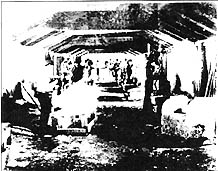 |
 |
|
The reformatory's first "agent and warden" was Silas W. Berry, a farmer and political figure from Norwich, NY. He was appointed in August, 1900 as the institution was preparing to open, at a salary of $3,500 plus maintenance (room and board). He arrived with his wife, his daughter, and his pet crow. He also brought a horse and a cow, and had his chickens sent after him. Since work on a warden's residence would not even begin for another five years, the Berry's moved into temporary apartments on the upper floors of the central structure.
The health of the inmates was generally good (early annual reports repeatedly point to universal weight gains) and there were no deaths in the first two years. Four inmates died in 1903, of nephritis, neuralgia, meningitis, and heart disease. In 1904, two inmates hanged themselves, and the institution recorded its first death from tuberculosis; cases of TB would rise rapidly over the next 10 to 15 years, as they did in other prisons and the free population of New York State. But by and large, health remained good, owing to regular outdoor activity -- the institution "program" was construction and farming -- and reasonably good nutrition and medical care. In the first years, no prison industries were established at Napanoch, and its prisoners were officially classed as "idle" by the Prison Department since they generated no income to the state. In fact, they were anything but idle. Prisoners toiled mightily -- building and farming, saving a great deal of money that would otherwise have been paid to outside contractors and food vendors. They were engaged in leveling the slope from the mountain ridge to the creek, grading the grounds, laying a temporary 1,500 foot sewer (a job entailing changing the course of a mountain stream and constructing a canal), building roads about the facility, and plastering and bricking the cells in the North and South wings. They also manufactured all their own clothing and shoes . . . . An icehouse was built adjacent to a pond. A horse barn, hen house, hog pen, and a shed for storage of wagons, sleighs, and farm tools were built. A sewage disposal plant was constructed, enabling the men to fill in the "sinks and trenches" in use before. A temporary stockade fence was erected around the prison -- the permanent 2,800-foot concrete wall would take a quarter century to complete. Prisoners broke 1,100 cubic yards of stone by hand in 1902; in 1903, a 200 by 20-foot building was erected specifically for breaking and cutting stone, and in 1907, work picked up speed with the purchase of a stone crusher. Warden Berry discovered that, of the 272 acres comprising the reformatory property, only 20 were tillable, the rest either mountainous or exhausted by lease farmers in the preceding years. He recommended that additional land be purchased, and also requested funds for a green house. In the interim, the farm appears to have been surprisingly productive, supplying 4,500 pounds of pork the first year and a great many vegetables.
The superintendent reported happily in 1902 that the Ellenville and Kingston branch of the Ontario and Western (O&W) Railroad had been built through state property, with a depot and freight-house within 600 feet of the prison. The anticipated completion of the railroad had been one of the factors in the decision to select Napanoch for the prison, as it would greatly reduce transport costs for coal, freight, and prisoners. In 1904, during Warden Jacobs Snell's tenure, prisoners built a road to the railroad station, and one to King's Highway (today's Route 209). . . Aside from labor, there was absolutely nothing in the way of a correctional program. The only diversions were the Sunday religious service and the loan of one book a week from the library, stocked the first year with 683 volumes and periodicals contributed by local citizens, churches, and the Christian Endeavor Society. |
To |
To Correction |
To |